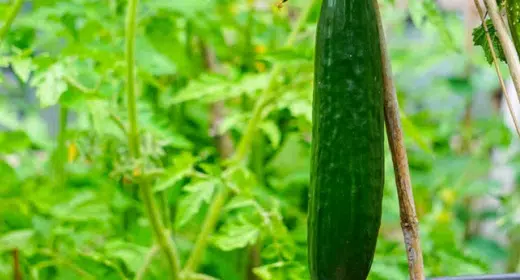by Kerin Gould: Grow these delicious, kid-friendly vegetables with a few expert tips…
The cucumber plant germinates easily, grows quickly, and produces lots of crunchy, kid-friendly vegetables, making this a rewarding crop for beginners as well as a trusty market-garden staple. If you have room in the garden, they can vine horizontally but if not, vertical gardening on a trellis can optimize your space.
Either way, choose a variety that is well-adapted to your climate, prepare your soil, and soon you’ll be crunching on pickles or cucumber salads. Here is everything you need to know to help your cucumbers thrive this season.
| Botanical name | Cucumis sativus |
|---|---|
| Common name | Cucumber |
| Plant type | Annual vine |
| Size | 6-8′ |
| Sun exposure | Full sun |
| Soil type | Well-drained, sandy loam |
| Hardiness zones | 4-11, depending on the variety |
| Native Area | India |
How to Plant Cucumbers
Cucumbers grow very much like their pumpkin and melon relatives; they prefer starting on a mound or ridge to ensure good drainage. Prepare your soil, removing weeds and debris, add well-rotted manure or compost, then make a ridge about 4-6 inches high and 3 feet apart, or mounds 5 inches apart.
Growing From Seed
Once soil temperature reaches about 65 degrees F, use a hoe to make a narrow trough down the middle of the ridge. Drop 3-4 seeds into the trough or plant 3-4 seeds per mound about a half-inch deep. Once they sprout, make sure plants have at least a foot of space between them. Trellis the plants as soon as possible and cover them with a floating row cover to keep them warm and protect them from pests. Mulch around the plants to keep moisture in the soil and protect any fruits that are touching the ground.
Transplanting From a Starter
If you’re starting cucumbers indoors, use peat pots or a similar container that will quickly break down as the plant grows. That way, the roots are not disturbed when planted. Start seeds 2-4 weeks before frost has passed and the soil is warm.
Cucumber Plant Care
Cucumbers seem to thrive when everything is regular—that means temperatures, light, soil moisture, and nutrients. Keep an eye on growing conditions throughout the season.
Light, Temperature, and Humidity
Cucumbers are a full-sun, warm-season crop. They can be perfectly timed to feature in your summer gazpacho, as they do not germinate in cold soil or withstand even a little nip of frost. If you have a short growing season, plant indoors just a few weeks ahead of planting time as the soil reaches 60 degrees F.
Growing cucumbers in a greenhouse can extend the season and help maintain the ideal 60-70% humidity. Seed companies breed cucumbers specifically for greenhouse growing.
Soil, Nutrients, and Water
Cucumbers thrive in soil that retains water, but not too much. A good amount of compost mixed in will improve the nutrients as well as the structure of your soil. The University of Georgia Extension recommends working in a balanced vegetable fertilizer before planting, then putting nitrogen-centric fertilizer 6 inches from the base of the plant when plants start to bloom and again three weeks later. A study conducted at University Wasit in Iraq found that a humic fertilizer applied to soil, plus a foliar feed with Vegeamino, a source of amino acids, improved harvests.1
A Note on Foliar Feeding
Roots aren’t the only part of the plant that can absorb nutrients; leaves can, as well. Spray an appropriate mixture, such as a liquid seaweed-based food or a tea from your homemade plant food, on both sides of the leaves until the liquid runs off. Don’t spray in direct sunshine, as the leaves’ pores aren’t open, and the spray residue may scorch the leaves.
Cucumbers have shallow roots, so water regularly rather than deeply. Water-stressed plants will make bitter, misshapen, or discolored fruit. A drip system on a timer will give the plants regular moisture.
Common Pests and Diseases
According to the National Gardening Association, cucumber beetles are a triple threat. The grubs chew on the roots, adults chew leaves, and as they move around spread diseases. Floating row covers will deter them, but they must be removed when plants flower so bees can get in to pollinate.
Powdery mildew causes white spots on leaves and vines. Mildew-resistant varieties and good air circulation can help prevent this disease.
Cucumber Varieties
The different types of cucumbers offer surprising variety, and there are a few things to note about the most common kinds:
- Straight Eight or Marketmore varieties are the slicing cucumber standard, firm and crisp, perfect for salads or dipping.
- Armenian cucumbers are long and large, deeply ridged, and pale-skinned with a mild flavor. For folks who get burping fits from cucumbers, Armenian and other burp-less varieties, are the best way to enjoy crunchy cukes.
- Japanese, Persian and English cucumbers are long and thin, dark green, ridged, and crunchy. Their slightly sweet flavor and small seeds make them ideal for Japanese pickles, sushi, or genteel cream cheese sandwiches.
- Pickling varieties such as Boston Pickling, Gherkin, or Kirby are harvested when they’re just 4- 5 inches long and are ideal for making homemade pickles. Use small ones whole as gherkins or cut them into spears for pickling with lots of dill. Straight Eight, if picked while small, can also be used for pickles.
- Lemon cucumbers are fierce growers and provide lots of personal-sized, pale yellow cucumbers with excellent flavor. Don’t let them get too large, or they will have more seeds in the middle than flesh.
- Container- and greenhouse-friendly hybrids are available in many seed catalogs, as are compact bush types for small spaces.
How to Harvest, Store, and Preserve Cucumbers
Cut stems just above the cucumber when they reach your preferred size, but do not let them get too big. Leaving large cucumbers slows down the growth of new fruit, and they will taste bitter and most likely end up in your compost bin.
Keep fresh cucumbers in your fridge’s vegetable crisper, where they will last for about a week. Pickle as desired.
-
What is the best way to grow cucumbers?
Growing cucumbers from seed is the most effective way. Plant 3-4 seeds about a half-inch deep, leaving about a foot of space between each plant.
-
Do cucumbers need to climb?
Cucumbers grow best when they can climb. If you have room, vine the plants horizontally. Otherwise, use a trellis so they can grow vertically.
-
Which month should you plant cucumber seeds?
Cucumbers are warm-weather crops. Aim for late spring or early summer to begin planting. The soil should be about 65 degrees F.
Source: Tree Hugger





















































